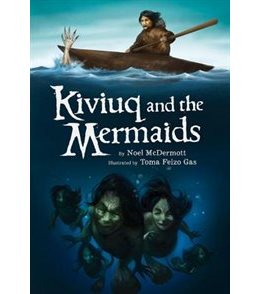| ________________
CM . . .
. Volume XXIII Number 19. . . .January 27, 2017
excerpt:
Kiviuq and the Mermaids revolves around Kiviuq, a legendary wanderer in Inuit culture who is known throughout the Arctic. In this story, Kiviuq’s journey begins at sea with other hunters. They follow a seal who leads them further out into the ocean. Kiviuq realizes that the animal is not an ordinary seal when it begins a chant to call the weather to its aid. A storm arises, and Kiviuq only survives with the help of the spirits of the sea bird and polar bear. However, all the other hunters have disappeared and have likely perished. Kiviuq is alone and thinks about the chant the seal used. He is familiar with it as an older woman in his village who was a shaman sang it and passed it down to her grandson. Kiviuq knew that the woman’s grandson had been taunted by many of the men in village, though he, himself, had provided food to their family. Kiviuq realizes that the grandson must have been the seal who led the hunters to their deaths, and he is thankful that he chose to show the grandmother and grandson kindness. Unfortunately, after the storm, Kiviuq is far away from his home, and he decides to rest before beginning his journey back. He hunts seals for nourishment and builds up his strength before beginning his return trip. On the day that he sets out, a mermaid stops him. Remembering the warning he received from his elders regarding mermaids, he is wary of her as she begins to cause him trouble. While he is able to fight her off, she returns with many of her relatives who are intent on causing him harm. He must use all his cunning to evade them and survive. Readers familiar with Arctic legends will likely be familiar with Kiviuq the hunter and his adventures involving him having to defend himself from spiritual beings. The events, which are of a mythic nature, take place in a time long ago and are being retold through a narrator. Given that the book is of a myth and legend genres, the events are not plausible; however, there are not any inconsistencies which could cause the readers to become critical of the story. One theme presented in the book is the importance of demonstrating kindness to others. In the beginning of the tale, readers see how Kiviuq’s actions in the past have a lasting effect on him. While he didn’t choose to be kind to the grandmother and her grandson in his village out of fear or belief that it would be valuable to him at a later point in life, he is saved due to his earlier kindness while the other hunters, those who had demonstrated cruelty to the boy, suffer for their actions. The story also refers to Kiviuq’s mindfulness of the advice he has received from elders regarding creatures and elements in the wilderness. Due to his elders’ advice, he is not only aware of the spirits of the sea bird and the polar bear and the limits of their assistance to him, but he remembers his need to be on his guard should he encounter mermaids. The style of narrative which is used in the book changes throughout and begins in the first person with the narrator musing how to begin the story. The story quickly switches to third person, focussing on Kiviuq’s time at sea. At the close, the narrative style returns to first person, with the narrator asking readers what they thought Kiviuq dreamt about. Another interesting stylistic choice is the incorporation of Inuktitut terms. Each word is translated the first time it is used in the story as well as being included in the glossary of Inuktitut terms at the end of book. Some of the terms are used relatively consistently in the story in place of the appropriate English word, such as qujaq for one-man boat, while others were introduced but continually used interchangeably with their English equivalents. Aside from the Inuktitut terms, readers will likely be familiar with the vocabulary used. The colour illustrations depict the mermaids in ways with which readers will likely not be familiar. Rather than beautiful young women who seem harmless, the mermaids are demonic looking, with sharp teeth and nails ready to be used to attack Kiviuq and his boat. While the illustrations depict scenes throughout the story, the eerie and menacing nature of the images of the mermaids amplify the dramatic fight that Kiviuq must win in order to escape with his life. Recommended. Meredith Harrison Lim is an MLIS graduate working for the Federal Government in the National Capital Region.
To comment
on this title or this review, send mail to cm@umanitoba.ca.
Copyright © the Manitoba Library Association. Reproduction for personal
use is permitted only if this copyright notice is maintained. Any
other reproduction is prohibited without permission.
Next Review | Table of Contents For This Issue - January 27, 2017 |
